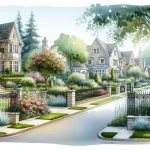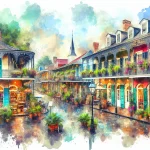The Lower Garden District, a captivating neighborhood in New Orleans, blends history, architecture, and cultural richness. This charming area, once a separate municipality called the City of Lafayette, has evolved into a cherished part of the Crescent City that embodies its essence.
In This Article
TL;DR
- The district holds historical significance dating back to the early 19th century when English-speaking Americans founded it.
- Architectural gems like Greek Revival, Italianate, and Queen Anne styles grace the streets, showcasing the area’s architectural heritage.
- The district exudes a lively cultural atmosphere with diverse communities, local events, thriving businesses, and historic green spaces.
Historical Overview of Lower Garden District
Origins and Early Development: Founding Era and Initial Settlers
In the 1830s, the Livaudais Plantation, located outside New Orleans, was subdivided and sold to English-speaking Americans seeking to create a community distinct from the Creole and immigrant populations residing in the French Quarter. This area, initially known as the City of Lafayette, would later become the Lower Garden District.
The founding settlers, drawn by spacious lots and lush gardens, established a prominent residential enclave. The district’s name, “Garden District,” derived from the beautifully landscaped gardens adorning the early residents’ properties.
Transformation over the Centuries: Key Events that Shaped the District
As the 19th century progressed, the once-rural Lower Garden District became increasingly urbanized, with blocks subdivided and more homes built to accommodate the growing population. In 1852, the City of Lafayette was officially annexed by New Orleans, marking a pivotal moment.
Throughout the following decades, iconic landmarks like the St. Charles Avenue streetcar line facilitated transportation and contributed to the area’s development. The district also played a role in significant historical events, including the Civil War, when it served as a strategic location.
Preservation Efforts: How Historical Integrity is Maintained Today
Recognizing the Lower Garden District’s rich heritage, efforts have been made to preserve its historical integrity. Organizations like the Garden District Association and the Preservation Resource Center work to protect architectural treasures and promote responsible development.
Strict guidelines govern renovations and restorations of historic properties, ensuring the district’s character and charm are maintained. Additionally, its inclusion in the National Register of Historic Places safeguards its cultural and architectural significance.
Architectural Highlights
Overview of Predominant Architectural Styles
The Lower Garden District showcases diverse architectural styles reflecting New Orleans’ influences and eras. Greek Revival, with stately columns and symmetrical facades, graces many grand mansions. The Italianate style, characterized by ornate brackets and intricate detailing, also adorns the streetscapes.
Other notable styles include Queen Anne, with distinctive turrets and intricate woodwork, and Eastlake, known for elaborate ornamentation and geometric patterns. These styles coexist harmoniously, creating a visually stunning blend that captures the district’s architectural heritage.
Notable Buildings and Their Historical Significance
Among the district’s architectural gems is the Toby Hart House, a prime example of Greek Revival grandeur built in the 1850s, boasting imposing columns, intricate ironwork, and a curved flagstone walkway.
The Hines House, an Italianate marvel constructed in the late 19th century, exemplifies the style with ornate brackets, arched windows, and intricate detailing. This meticulously preserved residence offers a glimpse into the district’s rich architectural heritage.
Impact of Architecture on the District’s Identity
The Lower Garden District’s architectural legacy has played a pivotal role in shaping its identity and allure. The harmonious blend of styles, coupled with preservation efforts, has created a visually stunning streetscape that transports visitors back in time. The district’s architectural heritage is a source of pride for residents and a major draw for tourists seeking to experience New Orleans’ authentic charm.
Cultural Tapestry
Demographic Evolution and Its Impact on the Community
The Lower Garden District has undergone a fascinating demographic evolution, contributing to its rich cultural fabric. Initially settled by English-speaking Americans, the district later welcomed diverse immigrants, including Irish, German, and Italian communities, each leaving an indelible mark.
Today, the district is a melting pot of ethnicities, backgrounds, and lifestyles, creating a vibrant and inclusive community. This diversity is reflected in the neighborhood’s culinary scene, art galleries, and cultural events, fostering unity and appreciation for the area’s multifaceted heritage.
Local Festivals and Events that Define the District’s Cultural Scene
The Lower Garden District’s cultural scene comes alive through local festivals and events celebrating its unique identity. The annual Celebration in the Oaks at City Park transforms the park into a dazzling holiday display with festive activities.
The Oak Street Po-Boy Festival pays homage to the iconic New Orleans sandwich, drawing crowds to savor the flavors of the district’s renowned eateries. These events serve as vibrant expressions of the Lower Garden District’s rich cultural heritage and community spirit.
Prominent Cultural Institutions and Their Contributions to Local Heritage
The Lower Garden District is home to prominent cultural institutions that preserve and promote the area’s heritage. The Ogden Museum of Southern Art showcases a remarkable collection of works by artists from the American South, offering a window into the region’s artistic legacy.
The historic Latter Library, dating back to the 19th century, serves as a repository of knowledge and a hub for literary and cultural events, fostering intellectual discourse and appreciation for the written word. These institutions, along with local art galleries and performance venues, contribute to the Lower Garden District’s vibrant cultural landscape and ensure its heritage remains alive and celebrated.
Economic Dynamics
Overview of the Local Economy and Key Industries
The Lower Garden District’s economy is a dynamic tapestry woven from various industries and businesses. While historically rooted in residential development, the district has embraced diverse economic activities.
Retail and hospitality sectors thrive along the bustling Magazine Street corridor, offering unique shopping and dining experiences. The district is also home to a thriving arts and culture scene, with galleries, museums, and performance venues contributing to the local economy.
Additionally, the district’s proximity to educational institutions like Tulane University and Loyola University has fostered a vibrant student community, driving demand for housing, dining, and entertainment options.
Role of Tourism in the District’s Economic Landscape
Tourism plays a significant role in the Lower Garden District’s economic landscape, with the area’s rich history, architectural splendor, and cultural offerings drawing visitors worldwide. Guided tours, boutique hotels, and locally-owned restaurants cater to tourists, providing employment opportunities and contributing to the district’s economic vitality.
The iconic St. Charles Avenue streetcar line serves as a major tourist attraction, transporting visitors through the heart of the Lower Garden District and offering a glimpse into its grandeur. This symbiotic relationship between tourism and the local economy has fostered a thriving ecosystem of businesses and services catering to both residents and visitors.
Impact of Local Businesses on Community Development
The Lower Garden District’s local businesses are integral to the community fabric, contributing to its unique character and fostering pride among residents. Family-owned restaurants, boutiques, and artisanal shops add to the district’s charm and serve as gathering places, fostering social connections and a strong sense of community.
Many local entrepreneurs actively participate in neighborhood initiatives, supporting local causes and contributing to the overall development and well-being of the Lower Garden District.
Green Spaces and Public Areas
Major Parks and Their Historical Backgrounds
The Lower Garden District is home to iconic parks and green spaces that provide respite from the urban landscape and hold significant historical value. The renowned 1,300-acre City Park has been a beloved recreational destination for New Orleanians since its 19th-century establishment.
Within the park lies the New Orleans Museum of Art, a cultural gem housed in a stunning Greek Revival building. The park’s lush gardens, winding paths, and tranquil waterways offer a serene escape from the city’s hustle and bustle.
Role of Green Spaces in Community Interaction
Green spaces play a vital role in fostering community interaction and enhancing the quality of life in the Lower Garden District. Local parks and playgrounds serve as gathering spots for families, providing safe and inviting environments for children to play and neighbors to socialize.
Community gardens, such as the Parkway Partners Greenhouse, promote sustainable urban agriculture and bring residents together through shared gardening experiences and educational programs. These green spaces serve as the community’s heartbeat, fostering connections and promoting a sense of belonging.
How Public Areas Enhance the Quality of Life in the District
The Lower Garden District’s public areas, including tree-lined streets, pedestrian-friendly sidewalks, and vibrant commercial corridors, contribute significantly to the overall quality of life for residents and visitors.
The district’s walkable nature encourages outdoor exploration and physical activity, promoting a healthier lifestyle. Public art installations and murals adorn the streets, adding vibrancy and character to the urban landscape.
Additionally, public spaces host community events like farmers’ markets and outdoor concerts, fostering community pride and providing opportunities for social interaction and cultural enrichment.
Community and Lifestyle
Snapshot of Daily Life in the Lower Garden District
Daily life in the Lower Garden District is a tapestry woven with history, culture, and community. Residents wake to the gentle clatter of the iconic St. Charles Avenue streetcar that has transported generations through the district’s heart.
Mornings are often spent strolling tree-lined streets, admiring historic homes’ architectural grandeur or grabbing locally roasted coffee from cozy cafes. The district’s vibrant commercial corridors, like Magazine Street, come alive with shoppers browsing boutiques and diners savoring local eateries’ flavors.
As the day winds down, residents gather in parks and green spaces, enjoying outdoor activities or relishing the tranquility of these urban oases. Evenings bring a lively atmosphere, with locals and visitors flocking to restaurants, bars, and cultural venues, celebrating the Lower Garden District’s rich heritage.
Community Initiatives and Local Organizations
The Lower Garden District takes pride in its heritage and actively works to preserve and enhance its unique character. Organizations like the Garden District Association and the Preservation Resource Center advocate for responsible development, historic preservation, and community pride.
Community initiatives like neighborhood watch programs and beautification projects bring residents together to ensure safety and aesthetic appeal. Local non-profits and volunteer groups work tirelessly to address social issues, provide educational opportunities, and support vulnerable populations.
How Residents Contribute to the District’s Vibrancy and Charm
The residents are the heartbeat of the Lower Garden District, contributing to its vibrancy and charm through their passion and dedication. Many homeowners take great pride in maintaining their properties’ historic integrity, preserving the architectural legacy that defines the district’s character.
Local artists and craftspeople showcase their talents through public art installations, gallery exhibitions, and artisanal products, adding a unique flair to the district’s cultural landscape. Residents actively participate in community events, festivals, and celebrations, fostering a strong sense of camaraderie and shared identity.
Future Outlook and Developments
Planned Developments and Projects in the Area
The Lower Garden District’s future involves thoughtful growth and preservation, with several exciting developments and projects on the horizon. Plans are underway to revitalize the historic St. Charles Avenue streetcar line, ensuring this iconic transportation system continues serving residents and visitors for generations.
Additionally, the district is poised to welcome new mixed-use developments that will blend residential, commercial, and cultural spaces, catering to the evolving needs of the community while respecting the area’s architectural heritage.
Preservation Challenges and Opportunities
While the Lower Garden District’s future holds promise, preserving its historic character presents challenges. Rising property values and development pressures pose potential threats to architectural integrity, underscoring the importance of robust preservation efforts.
However, these challenges also present opportunities for innovative solutions and collaborative efforts between residents, developers, and local organizations. Adaptive reuse projects, repurposing historic buildings for modern uses, offer a sustainable approach to preserving architectural legacy while meeting contemporary needs.
Potential Changes in the Socio-Economic Landscape
As the Lower Garden District continues evolving, its socio-economic landscape may undergo shifts. Gentrification and rising housing costs could potentially impact diversity and affordability, prompting discussions around inclusive development strategies and affordable housing initiatives.
However, the district’s strong sense of community and commitment to preserving its cultural heritage may serve as a counterbalance, fostering an environment where diverse populations can coexist and thrive. Proactive measures, such as community-driven economic development initiatives and support for local businesses, could help maintain the district’s unique character while embracing positive change.






